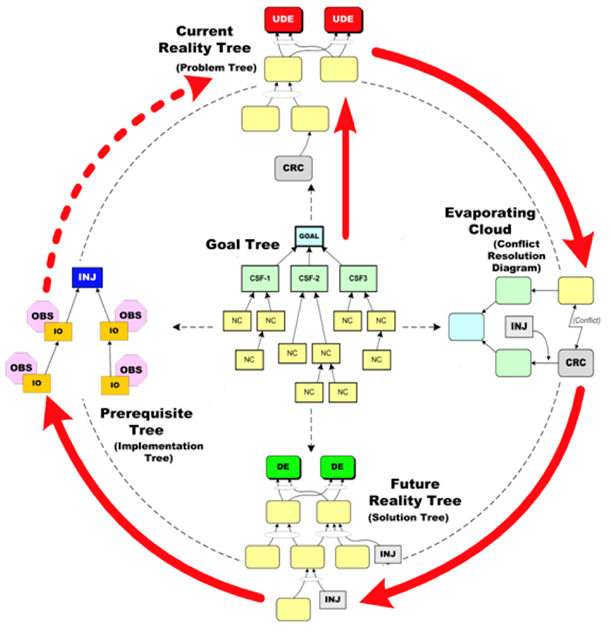“You cannot connect the dots looking forward, you can only connect them looking back”, as Steve...
 The Logical Thinking Process was originally developed by Dr. Eliyahu M. Goldratt, author of the bestselling business novel „The Goal“ and pioneer of modern production and process management, as a method to improve decision making in the corporate environment. The purpose of the Logical Thinking Process is to help people make better use of logic and the methods of the natural sciences to analyze complicated situations and formulate a strategy. Everyone who works in the area of financial planning and analysis knows how important it is to have a clear view of the links between causes and effects when it comes to formulating and implementing performance analysis. This is precisely what the Logical Thinking Process helps us to do.
The Logical Thinking Process was originally developed by Dr. Eliyahu M. Goldratt, author of the bestselling business novel „The Goal“ and pioneer of modern production and process management, as a method to improve decision making in the corporate environment. The purpose of the Logical Thinking Process is to help people make better use of logic and the methods of the natural sciences to analyze complicated situations and formulate a strategy. Everyone who works in the area of financial planning and analysis knows how important it is to have a clear view of the links between causes and effects when it comes to formulating and implementing performance analysis. This is precisely what the Logical Thinking Process helps us to do.
Later refined by H. William Dettmer, author of „The Logical Thinking Process – A Systems Approach to Complex Problem Solving“, the key book on the subject, it is a set of five tools that lead you from defining the goal of your organisation or project towards mapping the way towards the future. What distinguishes the Logical Thinking Process from most strategy formulation methodologies is its focus on rigid logical and scientific approach at all stages of the analysis. This is where the alternatives are usually lacking, probably one of the main reasons over two-thirds of strategy projects eventually fail.
But why should someone want to learn how to think logically? We are all able to, are we not? In fact, that is mostly true. We are generally quite able to draw correct conclusions from the facts presented to us, to identify the fallacy in a simple, wrong, if-then statement, and to build a sound deduction from valid assumptions.
However, most of us can do this only to a certain extent, that is, as long as the situation is not too complex. But the fact is that very often it is.
I recently watched a documentary about Magnus Carlsen, the world champion of chess. Carlsen is a true wonderchild. He became the grand master of chess when he was thirteen and at twenty-three he was world champion. As most of us know chess is a strategic game that relies on logic. The player has to build a strategy and evaluate the possible reactions of the opponent, not only in the next move but many moves ahead. The possibilities soon become so many that most of us give up trying to predict them. This is why chess is so damn hard to become good at.
The most memorable scene from the movie is when Carlsen played against a bunch of highly skilled chess players and won them all. Winning them all was, of course, an achievement most of us could only dream of. But during the event, Carlsen was actually blindfolded. Not only did he have to memorise each position accurately. He also had to formulate in his head his own strategy towards each of his opponents without even having the visual reference of the chess table. What Carlsen was in fact doing was to run in his head several different, highly complicated simulations, logical systems of if-then statements with probabilities attached to each of those.
If an average person tried to predict 10 moves in a chess game nothing much would come out of that. But now let‘s assume they had more time and a simple framework to construct the sequence of possible moves, a tree of cause and effect they could use to visualize the prediction. This would be a game-changer. With the help of the logical tree structure more or less anyone should be able to predict the 10 moves and in fact, the quality of their prediction would probably not be inferior to the quality of Carlsen‘s prediction.
So, what does this tell us? It tells us is that even if none of us can predict a sequence of moves in our heads like Carlsen does, there is, in fact, no difference in the ability to understand and formulate the logic as such. It just takes us longer and we need the right tools to do it. For chess is not a mystical game. It is a logical game and therefore anyone who can think logically can understand the flow of logic in a game of chess.
Now let‘s think about strategy. Not the strategy of the chessboard, not a military strategy, but a business strategy. In business, just like in chess, the goal is to win. To outperform the competition. In order to get there, we must build a strategy that takes us to the goal. We must decide our actions and predict the actions and reactions of the competitors. And this we must do many moves ahead just like in a game of chess.
"... the Logical Thinking Process is in fact not a tool to teach us to think logically, for we all can. It is a tool that helps us to take full advantage of our innate ability to think logically ..."
The potential moves are fewer, certainly. But instead, we have other complications in business that we don‘t have in chess. In chess, it is just the players and their strategies. In business we also have the market, we have the government, we have an external environment we don‘t control and that can change in unpredictable ways.
And furthermore: On the chessboard, we can move the pieces around as we like. The knight will stay where I put it. But the knights, pawns and rooks in our companies are not this easy to deal with. If the human knight puts up passive resistance instead of playing his part in the strategic move, depending on his participation, it may come to nothing. If the pawns rebel we may have to find a different way. In other words, the corporate strategy must take into account not only a highly unpredictable external environment but also the internal environment driven by the apparent chaos of politics, hidden agendas and tacit relationships. This is well known to all who deal with planning, budgeting and strategy in corporations.
So, if clear logical visualization can enable us to understand the strategy of a chess grandmaster ten moves ahead, what about when it comes to formulating a coherent and logically tight strategy for a company, dealing with unpredictable external and internal enviroment? Or analyzing a complex situation to figure out root causes and formulating solutions? In such cases, it is a real breakthrough to have a tight framework, based on sound logical and scientific methods to help us build visual, easy-to-understand strategies and analyses. This way the Logical Thinking Process can really help the FP&A expert correctly identify the key measures that need to be tracked, and build planning and performance management solutions based on them.
The flow of the Logical Thinking Process, courtesy of H. William Dettmer
The Logical Thinking Process is just such a tool. It leads us from the definition of the goal we wish to achieve to determining the roots of the undesirable effects of underlying problems, finding the conflicts behind them and finally formulating the plan towards a solution. All visual and easy to understand. All logically and scientifically watertight when done correctly.
And no less importantly, the Logical Thinking Process not only helps us structure our own thoughts and analyses. For by visually displaying the links between causes and effects, in a way everyone can understand, it becomes much easier for those not involved in building the analysis to understand it, spot any logical flaws, and/or add further important refinements. This way the Logical Thinking Process is actually a very strong tool to enhance collaboration and improve communication.
So, the Logical Thinking Process is in fact not a tool to teach us to think logically, for we all can. It is a tool that helps us to take full advantage of our innate ability to think logically, a tool that helps us cut through the complexity of a situation – just like a visualized sequence of chess moves would enable us to understand the player‘s strategy – and to communicate our insights to others in a clear and compelling way.
Subscribe to
FP&A Trends Digest

We will regularly update you on the latest trends and developments in FP&A. Take the opportunity to have articles written by finance thought leaders delivered directly to your inbox; watch compelling webinars; connect with like-minded professionals; and become a part of our global community.


 An INSEAD MBA and entrepreneur Thorsteinn has over 20 years of experience in management, consulting and training. He is chairman of Ultima BV, a company specialized in developing driver-based planning and budgeting solutions. He also runs his own consultancy with a focus on improving business performance, using the Beyond Budgeting approach to planning and budgeting, and the Logical Thinking Process methodology for strategy formulation and improvement programs, both in consulting assignments and corporate training. Thorsteinn is a member of the Beyond Budgeting Roundtable and a certified expert in The Logical Thinking Process.
An INSEAD MBA and entrepreneur Thorsteinn has over 20 years of experience in management, consulting and training. He is chairman of Ultima BV, a company specialized in developing driver-based planning and budgeting solutions. He also runs his own consultancy with a focus on improving business performance, using the Beyond Budgeting approach to planning and budgeting, and the Logical Thinking Process methodology for strategy formulation and improvement programs, both in consulting assignments and corporate training. Thorsteinn is a member of the Beyond Budgeting Roundtable and a certified expert in The Logical Thinking Process. 


